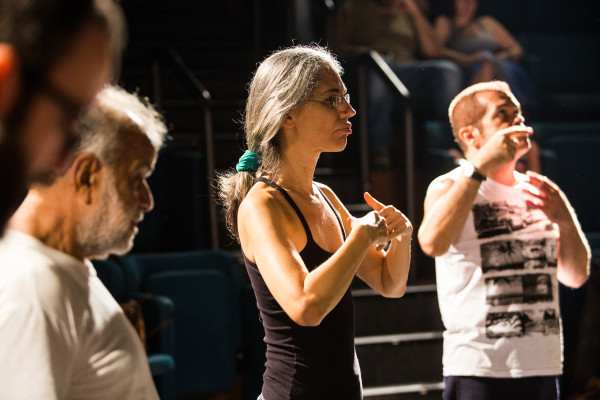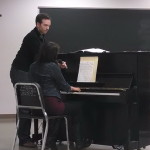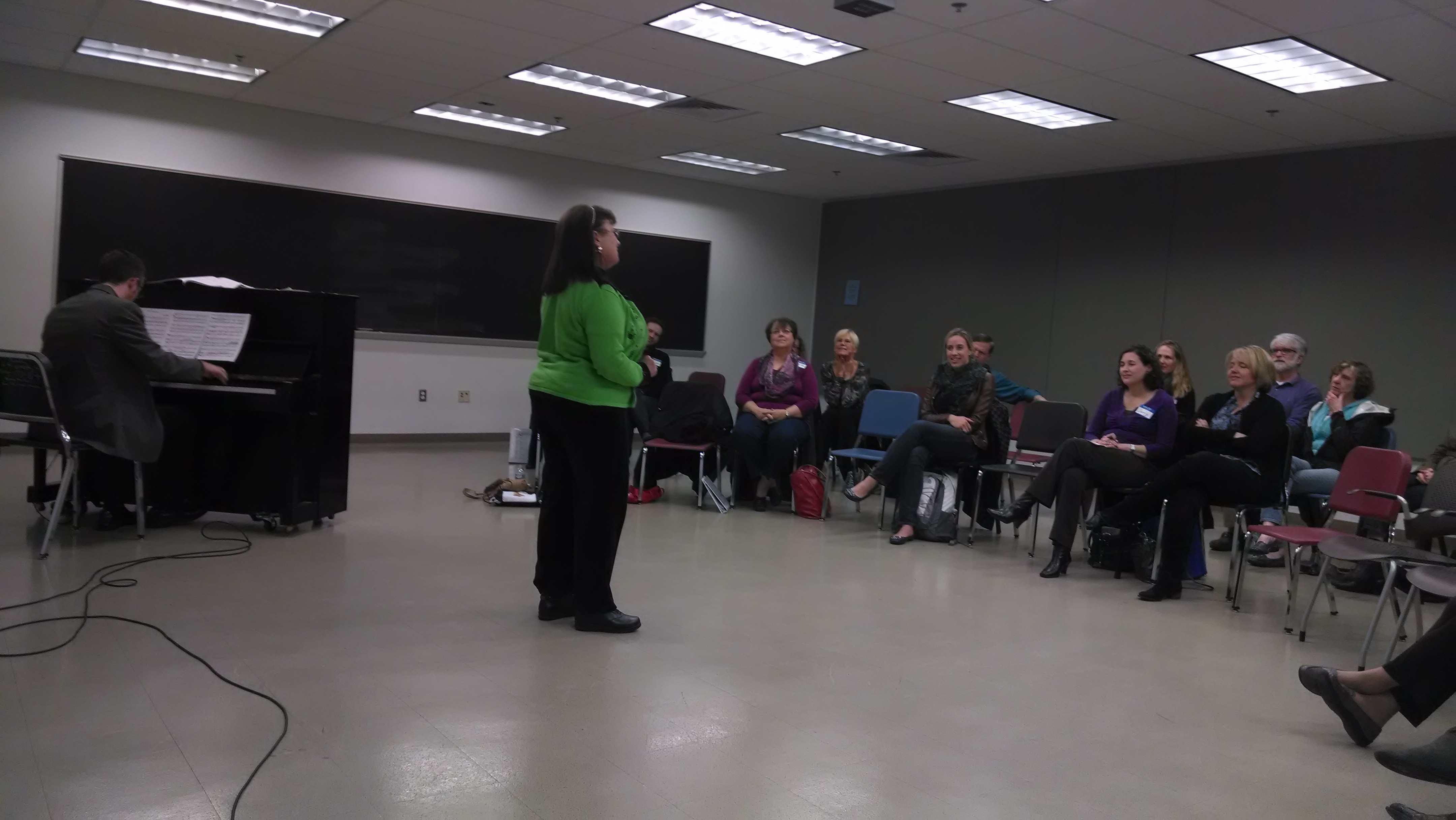by Jeffrey D. Costello
Not a concert where each choir sings one or two songs to a CD accompaniment track, but a real pop/rock concert with a real pop/rock backing band. How does one go about accomplishing this? What is involved? What are the things one should do to achieve a successful performance, and what are the things one should not do?
I have been the Director of Choirs at Creekside Middle School in Zeeland, Michigan since 1996. I’ve also been a professional drummer, vocalist, and guitarist since 1985, with extensive performing experience in the pop/rock field as a member of the Michigan-based bands Paris Blue and Cos & Cos. Paris Blue toured the Midwest from 1991 from 1995, playing venues in 14 states as a regional touring rock act, performing 300 nights per year in 200 to 1,700 seat venues. I’ve also worked as a live sound engineer for 20 years, and a recording studio owner/operator for 14 years, recording, mixing, editing, and mastering local talent, including everything from hard rock acts to church choirs.
My school choirs sing a balanced repertoire, but due to my extensive performing, arranging, and composing of Contemporary Commercial Music (CCM,) I tend to program more CCM material than most choir directors. This article will serve as a “how to” for choir directors interested in staging a full-blown live rock concert with their choirs.
Voice Training
It all starts here. The vast majority of public school choir directors are classically trained musicians who have little experience singing, teaching, and in many cases, even listening to CCM styles of music. In order to properly train vocalists to sing CCM styles, I recommend that teachers seek additional training beyond what most colleges and universities offer. In order to truly understand a musical genre it’s vital to be immersed in it, first by listening. A choral pop/rock concert sung all in head register, with tall, dark vowels would be stylistically inappropriate. Just as singing Handel, Bach, or an art song in a belt sound with bright, spread vowels would be equally as inappropriate. I train my choirs and private students to sing in, and respect, all vocal styles. The tool I use to achieve this is Somatic Voicework™ The LoVetri Method. Ms. LoVetri’s method of voice teaching is both intuitive and science-based, training the ear, the body, and the mind to change styles seamlessly as deemed by the repertoire. It is registration-based training, meaning the vocal muscles of head voice and chest voice are coordinated and strengthened in a systematic fashion with specific vowels, tonal patterns, and dynamics.
One way I apply The LoVetri method to my work is in the process of teaching middle school choristers who are just learning to sing in harmony. If, for example, my altos are accidentally singing the soprano part, I ask them to check which vocal register they are using. If the music calls for the altos to sing around middle C, and they are singing in head register rather than chest register, chances are good they are not singing their part, but are singing the head-register dominant soprano part by mistake. In that moment I remind the altos “It’s a register thing!” and, as they develop, they learn to match the feeling of the registration to find the correct pitches in the lower range.
Another benefit of Somatic Voicework™ is that it teaches singers to mix, or sing in a
blend of chest and head registers. Singing in a mix is crucial for CCM vocalists, both male and female. Most CCM singing between E4 and B4 uses some form of mix. An exception to this is the belt sound, which refers to carrying chest register above E4. Somatic Voicework™ is also a great tool for teaching a healthy belt. Establishing in all singers’ minds that registration is a vocal fold event, and that vowels occur by shaping the pharynx and articulators differently is important to understand. From there we can move toward exercises that work all elements. Some exercises address bright or dark vowels, others address registration or articulation, and many address all components. The teacher must be able to discern a vowel change from a registration change in order to properly demonstrate and teach it.
I focus on bright vowels for CCM material and dark vowels for classical material before addressing registration at all. A typical warm-up for the choir would have them singing a five-tone scale (ascending and descending) on “ah” as in “father” for the bright sounds. I then have them switch to “aw” for the dark sounds. We go back and forth every other half-step. These types of exercises keep the vocal instrument moving and flexible, which is a core principal of Somatic VoiceWork™.
In order for a singing voice to be balanced and healthy, a singer must have a strong head register and a strong chest register. My choirs sing a great deal of CCM literature, so they tend to use a bit more chest register than a typical middle school choir. I teach them to stay on the “oh” vowel above the primary passaggio and not let their vowel change to “ah.” I encourage them to lighten their registration gradually from chest, into more of a chesty-mix, into a heady-mix, and ultimately into head register.
Registration also plays a part in choral blend. When voices are in a similar pitch range, they need to be singing in the same registration. Particularly in CCM singing, females and tenors need to utilize chest register below E4 (primary passaggio) and as high as G4, depending on the dynamic level. Between E4-G4 and B4 some form of mix should be used. Above B4 the instrument will automatically go toward head register unless we override the system. Singing louder is one way to take a chestier sound higher than it would normally go in a softer passage.
Acoustics of the Performance Space
If the choral performances you normally direct are with piano accompaniment, chamber instruments, or are sung a cappella, you may not have considered the acoustics of the space, because in those situations it is most beneficial to perform in an acoustically live space. Anyone who has attended a performance in a church where CCM (with drums and electric guitars) is performed has likely noticed that those spaces are acoustically different from older churches and auditoriums that were acoustically designed for pipe organs, chamber instruments, and choirs. When presenting a CCM performance, in order to ensure a successful aural experience for the performances and audience, the performance space must be as acoustically dead as possible. This means if your school’s auditorium has a removable acoustic shell of any type, insist that it not be used for this performance. Instead, utilize curtains (the thicker, the better) to surround the stage. Acoustic “clouds” should also be placed in the non-reflective position. If acoustic enhancing surfaces are used, and the resulting acoustic space is too live, then drums, cymbals, and guitar amplifiers will become much to loud for the performers and the audience.
The Sound System and Engineer
In order to stage a successful choral pop/rock concert, the venue must have a high-quality, powerful sound system and qualified sound engineer. A concert like this requires much more of the sound engineer than simply turning up the solo mics, and because a Music Education degree doesn’t typically include any instruction pertaining to sound systems, microphones, or recording equipment (an injustice, in my opinion), you may want to hire a professional sound engineer if your school district does not employ one. The sound engineer will be able to determine whether or not additional equipment is needed to successfully stage the event. In my experience, most school auditoriums do not have adequate sound equipment to stage a full rock concert. If this is the case, renting of additional equipment may be necessary. In order to have it sound like a real pop/rock concert, we want all the sound the audience hears to be coming from the sound system. This is not your father’s choir concert! Everything will be miced. (The tech/production world has adopted the words “mic” and “miced” as official, correctly spelled, terms.) In other words, the miced sound of your choirs should overpower the acoustic sound that the audience typically hears. This is important because the volume of the backing band will otherwise drown out your choirs.
The Band and Their Equipment
The professionalism of the band you hire is important, including the quality of their instruments and equipment. This is not the time to let the local high school garage band perform with your choir. If you want a professional sound, hire professional musicians who use top-quality instruments and equipment. If you don’t know where to find these musicians, speak to folks at the local mega churches who perform CCM music, and reach out to their musicians. Many of these musicians play professionally in other areas and are often consummate pop/rock performers. These musicians will obviously require payment. From my experience, school choir concerts generally do not charge for attendance, but that needs to change for an event of this magnitude. I charged $3 per person for my recent Rock of Ages concert in a 960-seat venue, and easily raised enough to pay the musicians what they deserved, as well as purchase/rent all the needed equipment.
The use of a drum shield (an acrylic or plexiglass shield surrounding the drums to reduce stage volume) is also advised. For an event like this, the sound engineer will want to mic all the drums, believe it or not. This is the only way to get that punchy feel through the sound system that we’ve all experienced at pop/rock concerts. You also want to have the sound engineer closely monitor the volume level of the instrumentalists. Generally speaking, the louder the musicians play, the more difficult (even with choir mics) it will be to get the choirs out front in the mix. If you can find instrumentalists who use computerized modeling amps and ear monitors (a topic worthy of a complete and separate article), instead of traditional amplifiers and wedges, volumes will be much easier to manage.
Monitors
In every performance with drums and amplified guitars, the vocalists will need monitors to hear themselves, as well as to hear the accompaniment clearly. Your sound engineer should be able to assist with where to place the monitors (also known as wedges, due to their shape,) but they should be on the floor in front of the choir risers, and pointed at the singers. Solo mics should be fed to these monitors so the soloists can hear themselves. Choir mics should not be fed to the monitors because this will cause the unpleasant squealing sound we’ve all experienced. Depending upon the physical location of the band you may also need to place monitors near the instrumentalists so they can effectively monitor the singing, and make musical adjustments as needed, especially if the band is located away from the stage. (See next paragraph.)
Location of the Band
Where should you put the band? You could employ the traditional procedure of putting them on the stage, in front of the choir risers, but instrumental volume and balance with voices likely will become an issue with this setup. If an orchestra pit is available, this is a viable, but less exciting, option. You could have them set up in the wings, but that’s also not very visually appealing. For my Rock of Ages concert I wanted the audience to see the band, but I didn’t want the band to visually overshadow the choir, so I made the decision to purchase 40” legs for our Wenger portable staging units, and I placed the band behind the choir risers (see video link.) With the band behind the choir, it provided an exciting concert-like appearance, yet allowed the singers to still be the main focal point of the visual experience. Another viable option, and one I’m planning to use this year, is to put the band on one of the “tech decks” (an elevated area in front of the proscenium.) If your auditorium was built sometime over the last 20 years, you may have this as an option. With this setup, the drums and amplifiers are far enough away from the choirs that instrument “bleed” into the choir mics should not be an issue.
Light and Effects
In order to create the atmosphere of an authentic pop/rock concert, you will want to give consideration to lighting and special effects like fog. If your auditorium doesn’t have much in lighting, you may wish to rent additional lighting equipment, and consider hiring a lighting designer. Fog machines (hazers), moving lights, strobes, etc., greatly enhance the appearance of a pop/rock show. These effects can be rented if they are not available in your auditorium.
Conclusion
Staging a successful choir pop/rock concert is no easy feat, but with the right instrumentalists and equipment, it is an achievable goal that will provide your singers with a real life CCM performing experience. This type of experience is similar to what some students will be involved in after graduation in places of worship and community events. There is also the viable option of utilizing pre-recorded CD accompaniment tracks for an authentic pop/rock sound. My band accompanied the choirs on ¾ of the songs performed on our Rock of Ages concert. The other songs utilized CD accompaniment tracks.
Choir directors seeking to learn more about teaching and singing in CCM vocal styles should consider attending The LoVetri Institute for Somatic Voicework™ at Baldwin Wallace College in Cleveland, Ohio, USA.
Youtube link to video of my concert: https://youtu.be/GacXvkE7Nbs
Link to the local news spot: http://fox17online.com/2016/06/13/zeeland-middle-schoolers-rocks-audience-with-rock-of-ages-show/
Jeff Costello is available for consulting in all areas pertaining to live sound for choirs at parisblue3@gmail.com
Bio
Jeff Costello has been the choir director for Creekside Middle School in Zeeland, Michigan since 1996. He began his musical career as a professional drummer and vocalist for the band “Infynity” in 1985 and continues to perform (on drums, guitar, keyboards, and vocals) to this day. His current band, “Paris Blue” enjoyed a run as one of the top Michigan regional touring bands on the “A Circuit” From 1991 to 1995 when the band retired from full-time performing.
Jeff is a State Honors Choir Director Nominee, was director of choirs at Second Reformed Church (almost entirely classical choral literature) in Zeeland, Michigan from 2000 to 2010 and also maintains a busy private voice studio.





